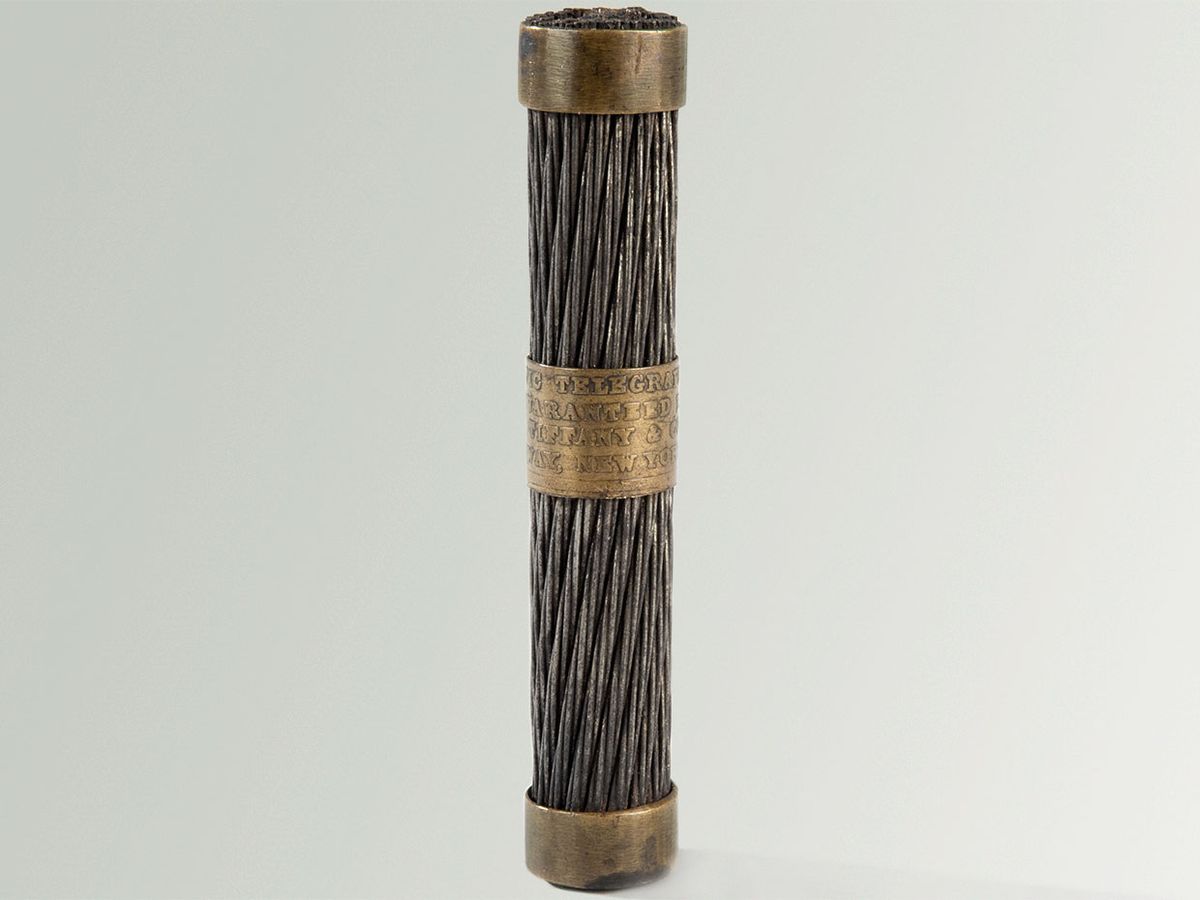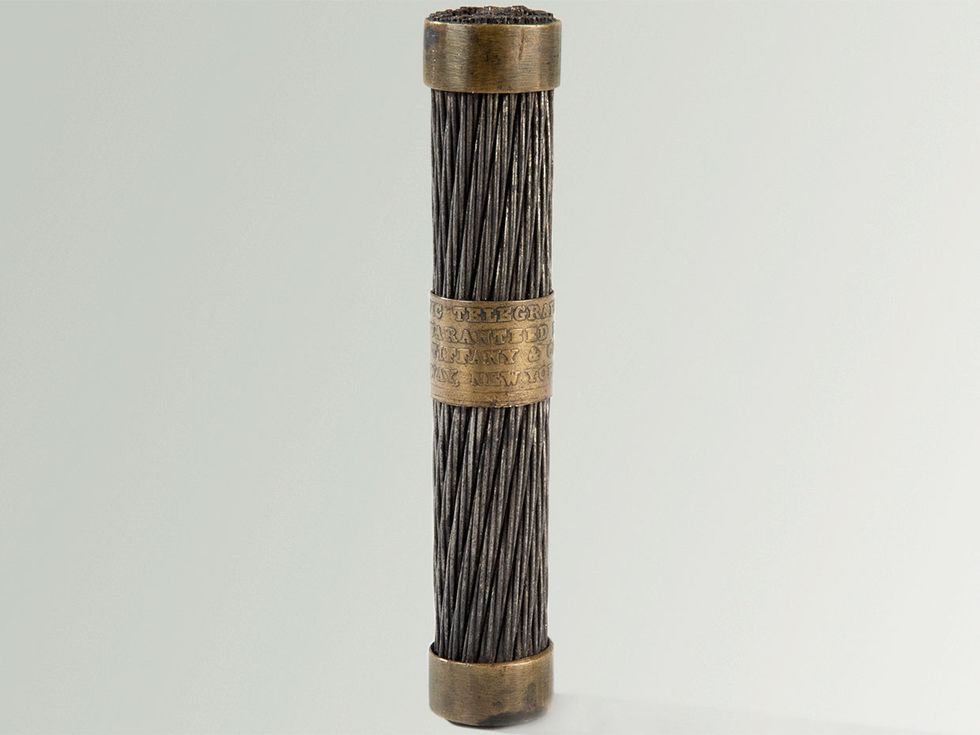
On 16 August 1858, Queen Victoria and U.S. president James Buchanan exchanged telegraphic pleasantries, inaugurating the first transatlantic cable connecting British North America to Ireland. It wasn’t exactly instant messaging: The queen’s 98-word greeting of goodwill took almost 16 hours to send through the 3,200-kilometer cable. Still, compared to packet steamships, which could take 10 days to cross the Atlantic, the cable promised a tremendous improvement in speed for urgent communications.
This milestone in telegraphy had been a long time coming. Samuel Morse first suggested linking the two continents in 1840, and various attempts were made over the ensuing years. Progress on the project took off in the mid-1850s, when U.S. entrepreneur Cyrus W. Field began investing heavily in telegraphy.
Field had made his fortune in the paper industry by the age of 34. The first telegraph project he invested in was a link from St. Johns, Newfoundland, to New York City, as envisioned by Canadian engineer Frederic Newton Gisborne. The venture never secured enough funding, but Field’s enthusiasm for telegraphy was undiminished. Over the next decade, he invested his own money and rallied other inventors and investors to form several telegraph companies.
The most audacious of these was the Atlantic Telegraph Company (ATC). Field and the English engineers John Watkins Brett and Charles Tilston Bright, both specialists in submarine telegraphy, formed the company in 1856, with the goal of laying a transatlantic cable. The British and U.S. governments both agreed to subsidize the project.
Terrestrial telegraphy was by then well established, and several shorter submarine cables had been deployed in Europe and the United States. Still, the transatlantic cable’s great length posed some unique challenges, especially because transmission theory and cable design were still very much under debate.
Morse and British physicist Michael Faraday believed that the conducting wire of a submarine cable should be as narrow as possible, to limit retardation of the signal. And the wider the wire, the more electricity would be needed to charge it. Edward Orange Wildman Whitehouse, an electrician for the Atlantic Telegraph Company, subscribed to this view.
The other school of thought was represented by William Thomson (later Lord Kelvin). He argued that the amount of retardation was inversely proportional to the square of the cable’s length. Thomson suggested using a large-diameter core made with the purest copper available in order to reduce the resistance. Bright, the project’s chief engineer, shared Thomson’s view. This design was significantly heavier and more costly than the one proposed by the Morse-Faraday school, and the ATC did not adopt it.
The Gutta Percha Co. manufactured the cable’s core and insulation. The core consisted of seven strands of copper wire twisted together to make a wire 0.083 inch in diameter. The finished core weighed 107 pounds per nautical mile, which was significantly lighter than the 392 pounds per nautical mile that Thomson and Bright had proposed. The copper core was wrapped in three layers of gutta-percha, a latex that comes from trees of the same name. The insulated core was then covered in tarred hemp and wrapped with iron wire. The finished cable was about five-eighths of an inch in diameter.
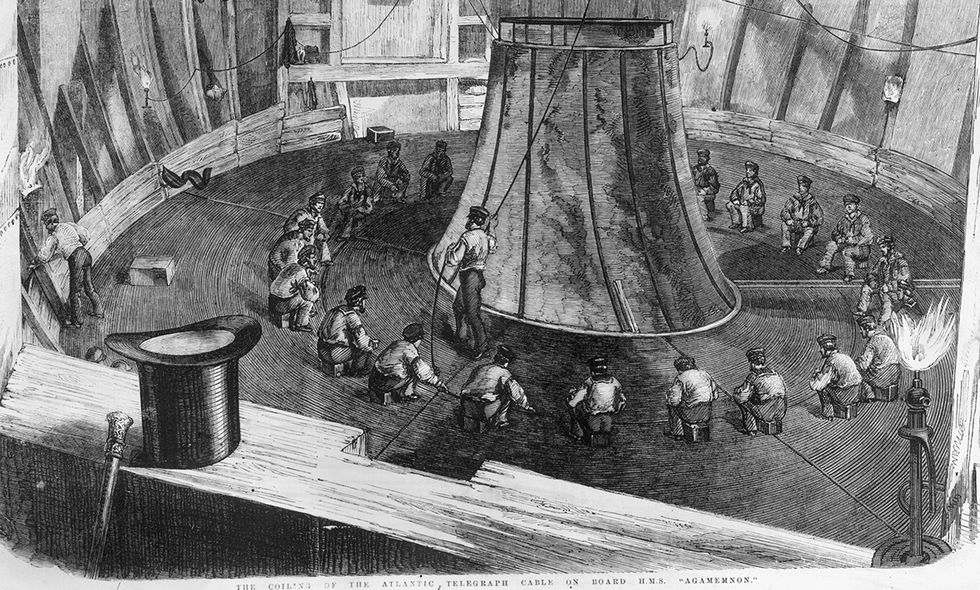
At the time, no ship could carry all of the submarine cable needed, so the cargo was split between two naval ships, the HMS Agamemnon and the USSF Niagara, both of which were refitted to carry the load. It took three weeks to load the cable. Many spectators gathered to watch, while local officials and visiting dignitaries treated the naval officers to countless dinners and celebrations, much of which was recorded and amplified by the press.
Of course, two ships meant that the cables would have to be spliced together at some point. Once again, there was disagreement about how to proceed.
Bright argued for splicing the cable in midocean and then having each ship head in opposite directions, paying out its cable as it went. Whitehouse and the other electricians preferred to begin laying the cable in Ireland and splicing in the second half once the first half had been laid. This plan would allow continuous contact with the shore and ongoing testing of the cable’s signal. Bright’s plan had the advantage of halving the time to lay the cable, thus lessening the chance of encountering foul weather.
The directors initially chose Whitehouse’s plan. Niagara and Agamemnon met at Queenstown, Ireland, to test the cable with a temporary splice. After a successful transmission, the ships headed to Valentia Bay to begin their mission, escorted by the USS Susquehanna and the HMS Leopard. Also joining the fleet were the support ships HMS Advice, HMS Willing Mind, and HMS Cyclops.
On 5 August 1857, the expedition got under way. The first portion of cable to be laid was known as the shore cable: heavily reinforced line to guard against strains of waves, currents, rocks, and anchors. But less than 5 miles out, the shore cable got caught in the machinery and broke. The fleet returned to port.
Willing Mind ran a thick rope to retrieve the broken shore cable, and crew members spliced it back to the shore cable on the Niagara. The fleet set out again. When they reached the end of the shore cable, the crews spliced it to the ocean cable and slowly lowered it to the ocean floor.
For the next few days, the cable laying proceeded. There was nearly continuous communication between Whitehouse on shore and Field, Morse, and Thomson on board, although Morse was incapacitated by seasickness much of the time.
The paying-out machinery was fiddly to operate. The cable was occasionally thrown off the wheel, and tar from the cable built up in the grooves and had to be cleaned off. To keep the cable paying out at a controlled rate required constant adjustment of the machinery’s brakes. The brakeman had to balance the ship’s speed and the ocean current. In perfect weather and flat seas, this was easy to judge. But weather can be fickle, and humans are fallible.
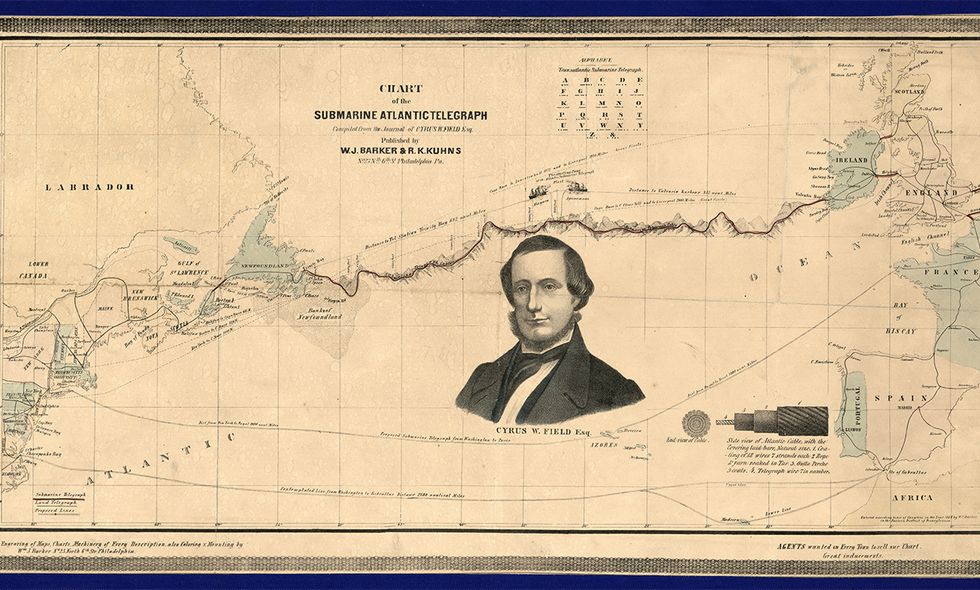
Around 3:45 a.m. on 11 August, the stern of Niagara headed into the trough of a wave. As the ship rose, the pressure on the cable increased. The brakes should have been released, but they weren’t. The cable broke and plunged to an irretrievable depth.
Field immediately headed to England aboard the Leopard to meet with the ATC’s board of directors. Niagara and Agamemnon remained at the site for a few days to practice splicing the cable from the two ships. Cyclops, which had done the initial survey of the route the previous year, conducted soundings of the site. When they returned to shore, the crews learned that the project had been halted for the year.
Over the winter months, William Everett was named chief engineer and set about redesigning the paying-out machinery with more attention to the braking mechanism and safety features. The crew practiced their maneuvers. Thomson thought more about transmission speed and developed his mirrored galvanometer, an instrument for detecting current in, say, a long cable.
The ships set out again the following summer. This time they would follow Bright’s plan. Agamemnon and Niagara would meet at 52°2’ N, 33°18’ W, the halfway point of the proposed line. In the middle of the Atlantic Ocean, they would splice together the cable and drop it to the ocean floor. Agamemnon would head east to Ireland, while Niagara headed west to Newfoundland.
Although the weather was fine when the ships set out, it soon turned. For six days, the two ships, laden with 1,500 tons of cable, pitched alarmingly from side to side. Although no one was lost, 45 men were injured, and Agamemnon ended up 200 miles off course.
Finally, on 25 June 1858 Agamemnon and Niagara met. The crews spliced together the cable, and the ships set off. At first, the two ships were able to communicate via the cable, but around 3:30 a.m. on 27 June, both logbooks recorded a failure. Because things looked fine on each ship, the crews assumed the problem was on the other end, and the ships returned to the rendezvous spot. The crews didn’t want to waste time investigating, so they agreed to abandon the 100 km of cable that had been laid and spliced together a new one, and the ships set off once more.
By 29 June, Agamemnon had paid out almost all of the cable stored on deck, which meant the crew would have to switch to the main coil in the middle of the night. Although they had practiced the maneuver over the winter, luck was not on their side. Around midnight, the cable snapped and was lost. As it turned out, the six-day storm had damaged the cable as it lay on the deck. The two ships were hundreds of kilometers apart by this point, and they headed back to Queenstown to await further direction.
Field was not deterred, but it took some doing to convince the rest of the ATC’s board of directors to make another attempt. He could be a persuasive guy.
The ships set out for a third time on 17 July 1858. This time the cable laying progressed without incident, having been blessed, finally, by the weather gods. On 29 July, as Field recorded in his journal, the two ships spliced the two ends of the cable together in the middle of the Atlantic Ocean, dropped it in the water at 1,500 fathoms (2,745 meters), and then each ship headed to its destination port. Niagara arrived on 4 August, Agamemnon the following day. The 3,200-km cable now connected Bay Bulls Arm (which was renamed Sunnyside in 1921), in Newfoundland, to Telegraph Field on Valentia Island, in Ireland.
By 10 August dispatchers were sending test messages, and on 16 August, with the queen’s and Buchanan’s exchanges, the line was officially open.
All of the project’s many starts and stops had been followed closely by the press and an eager public. Archaeologist Cassie Newland has called the heroic effort “the Victorian equivalent of the Apollo mission.”
The triumphant opening, after years of speculation and so many failures, was lauded as the communications achievement of the century. New York City celebrated with a parade and fireworks, which accidentally set the dome of City Hall on fire. Trinity Church in lower Manhattan held a special service to commemorate the cable, with the mayor of New York City and other officials in attendance and the Right Reverend George Washington Doane, Bishop of New Jersey, giving the address. On the other side of the Atlantic, shares in the ATC more than doubled, and Charles Bright was knighted for his work overseeing the project.
Of course, companies wanted to cash in on the celebration and immediately crafted all sorts of memorabilia and souvenirs. Niagara had arrived in New York with hundreds of kilometers of excess cable. The jeweler Tiffany & Co. bought it all.
Tiffany craftsmen cut the cable into 10-centimeter pieces, banding the ends of each piece with brass ferrules and attaching a descriptive plate [see photo at top]. The souvenirs retailed for 50 cents each (about US $15 today); wholesalers could buy lots of 100 for $25. Each piece came with a facsimile of a note, signed by Cyrus W. Field, certifying that he had sold the balance of the cable from Niagara to Tiffany. Although Tiffany claimed to have a monopoly on the cable, numerous competitors sprang up with their own cable souvenirs, including watch fobs, earrings, pendants, charms, letter openers, candlesticks, walking-stick toppers, and tabletop displays.
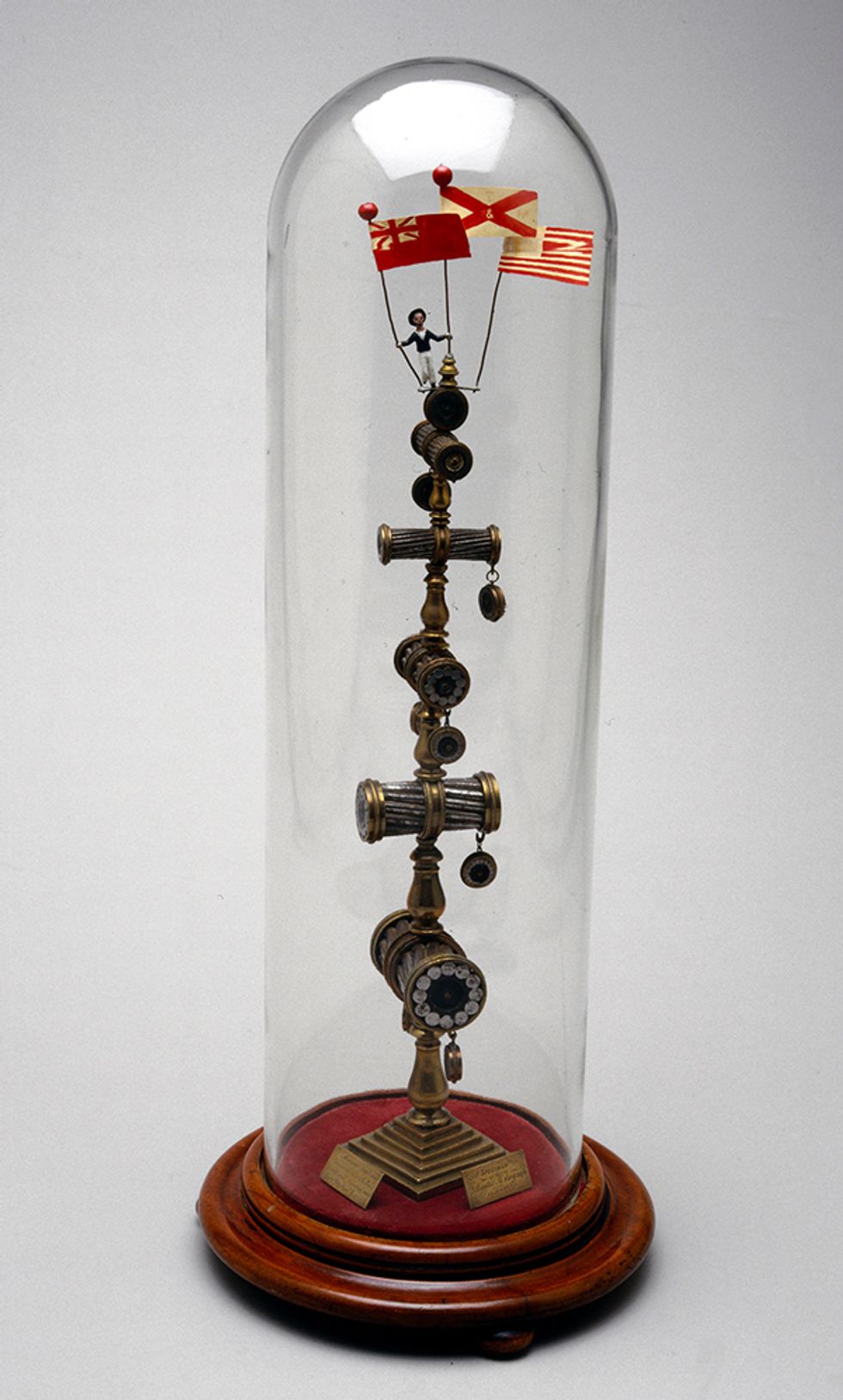
Tiffany reportedly sold thousands of its cable souvenirs, but it was a short-lived venture. Transmission on the transatlantic cable, never very strong, degraded quickly. Within a few weeks, the line failed entirely.
Blame for the failure quickly landed on Whitehouse, chief engineer for the eastern terminus of the cable. He believed that the farther the signal had to travel, the stronger the necessary voltage, and so he at times used up to 2,000 volts to try to boost the signal. Meanwhile, Thomson, the chief engineer for the cable’s western terminus, was using his mirror galvanometer to detect and amplify the faint signal coming through the cable.
In blaming Whitehouse for the failure, people were quick to point out his lack of traditional qualifications. This is a bit unfair—his path was similar to that of many gentleman scientists of the time. Trained as a medical doctor, he had a successful surgical practice before turning his attention to electrical experiments. Whitehouse patented several improvements to telegraphic apparatus and was elected a member of the British Association for the Advancement of Science. But the commission investigating the cable’s failure laid fault on Whitehouse’s use of high voltages.
In 1985 historian and engineer Donard de Cogan published an article that somewhat vindicated Whitehouse. De Cogan’s analysis of a length of cable that had been retrieved from the original deployment noted its poor manufacture, including the fact that the copper core was not centered within the insulator and at places was perilously close to the metal sheathing. Additionally, there was significant deterioration of the gutta percha insulator. De Cogan speculated that the impurities—which even Thomson objected to—along with improper storage over the 1857–58 winter resulted in a cable whose failure was inevitable. De Cogan also concluded, though, that having Whitehouse as a scapegoat may have actually helped advance transoceanic telegraphy. Had the cable failed without a cause, investors would have been more hesitant.
Regardless, the failure left Tiffany with thousands of unsellable souvenirs. Some ended up in museum collections, but many were put into storage and forgotten, leading to the next twist in this tale.
In 1974 a company called Lanello Reserves advertised the sale of 2,000 Tiffany cable souvenirs. The asking price was $100—about $500 in today’s dollars. Lanello Reserves also donated 100 pieces to the Smithsonian Institution, which the museum resold in its shops. Today, original transatlantic cable souvenirs pop up regularly in online auction sites. You too can own a piece of history.
While the souvenirs may have had a longer life than the transmission cable itself, that doesn’t diminish the accomplishment of Bright, Thomson, Whitehouse, and their teams. Even though the cable never worked well, a total of 732 messages were sent before it failed. These included the reporting of a collision between the Cunard Line ships Europa and Arabia, as well as an order from the British government to hold two regiments in Canada. The regiments were en route to India, but when the British government learned that the Indian Rebellion had been repressed, they sent new orders via the cable. By not sending the troops, the treasury saved an estimated £50,000 to £60,000, recouping about one-seventh of their investment in the cable with a single military order.
Public sentiment toward the cable quickly cooled, however. By the end of 1858, rumors abounded that this was all an elaborate hoax or a fraudulent stock scheme aimed at fleecing unsuspecting investors. Similar to today’s conspiracy theorists who refuse to believe that the Apollo moon landing was real, the cable doubters were not convinced by souvenirs, messages from heads of state, or effusive press coverage.
Field was eager to try again. Most of the ATC’s original financial backers weren’t interested in investing in another transatlantic cable, but the British government still saw the potential and continued to provide funding. The company finally succeeded in building a permanent transatlantic cable in 1866.
Field may have lost many of his friends and investors, but he never lost his optimism. He was able to believe in a future of instant communication at a time when most people didn’t have—indeed, couldn’t even conceive of—indoor plumbing and electric lights.
An abridged version of this article appears in the November 2019 print issue as “Tiffany’s Transatlantic Telegraphy Doodad.”
Part of a continuing serieslooking at photographs of historical artifacts that embrace the boundless potential of technology.
A correction to this article was made on 1 February 2021.
About the Author
Allison Marsh is an associate professor of history at the University of South Carolina and codirector of the university’s Ann Johnson Institute for Science, Technology & Society.
Allison Marsh is a professor at the University of South Carolina and codirector of the university's Ann Johnson Institute for Science, Technology & Society. She combines her interests in engineering, history, and museum objects to write the Past Forward column, which tells the story of technology through historical artifacts.
